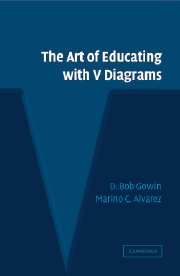Book contents
- Frontmatter
- Contents
- Foreword
- Preface
- Acknowledgment
- PART ONE FOUR COMMONPLACES OF EDUCATING PLUS ONE
- PART TWO THE V DIAGRAM
- PART THREE ANALYZING, EVALUATING, AND CONDUCTING RESEARCH
- PART FOUR REASONING WITH TECHNOLOGY
- Part 4 Summary
- Epilogue
- Appendices
- Appendix I V Diagram Scoring Protocol
- Appendix II Research Phases and Questions
- Appendix III Scoring Criteria for Concept Maps
- Bibliography
- Name Index
- Subject Index
Appendix II - Research Phases and Questions
Published online by Cambridge University Press: 19 November 2009
- Frontmatter
- Contents
- Foreword
- Preface
- Acknowledgment
- PART ONE FOUR COMMONPLACES OF EDUCATING PLUS ONE
- PART TWO THE V DIAGRAM
- PART THREE ANALYZING, EVALUATING, AND CONDUCTING RESEARCH
- PART FOUR REASONING WITH TECHNOLOGY
- Part 4 Summary
- Epilogue
- Appendices
- Appendix I V Diagram Scoring Protocol
- Appendix II Research Phases and Questions
- Appendix III Scoring Criteria for Concept Maps
- Bibliography
- Name Index
- Subject Index
Summary
The research phases and questions are presented as an example of those used with high school students using this electronic research strategy when conducting their case-based action research. The Exploring Minds Network has provisions for designing questions that are more suitable to other research methods and designs through an editing feature.
PHASE I. PROBLEM/SITUATION
Students are first presented with a case or a topic to be studied by the teacher or mentor. We have written cases on CDs that have included the use of thematic organizers with electronic links associated with interpretive statements designed to activate students' schema with topic; provided background information with hyperlinks to relevant source materials on the Internet; described key concepts that needed to be understood; and provided associative linkages to Internet sites that further elaborates on each of these concepts with either descriptions, examples, simulations, audio reports, video clips etc.
Directions to Students
Select either a problem that needs to be resolved or a situation that needs to be addressed that stimulates your interest. Relate the circumstances of the problem or situation to your own prior knowledge and experience. Reflect on this problem/situation by asking yourself:
How important is it to know more about this problem/situation?
Have I read about this situation/problem before?
Based upon what I have read or experienced how can I apply what I already know or have experienced to this problem/situation?
How can I make this problem/situation interesting for me?
Phase II. plan/strategy
Formulation
Formulate an idea or a problem.
- Type
- Chapter
- Information
- The Art of Educating with V Diagrams , pp. 207 - 214Publisher: Cambridge University PressPrint publication year: 2005



